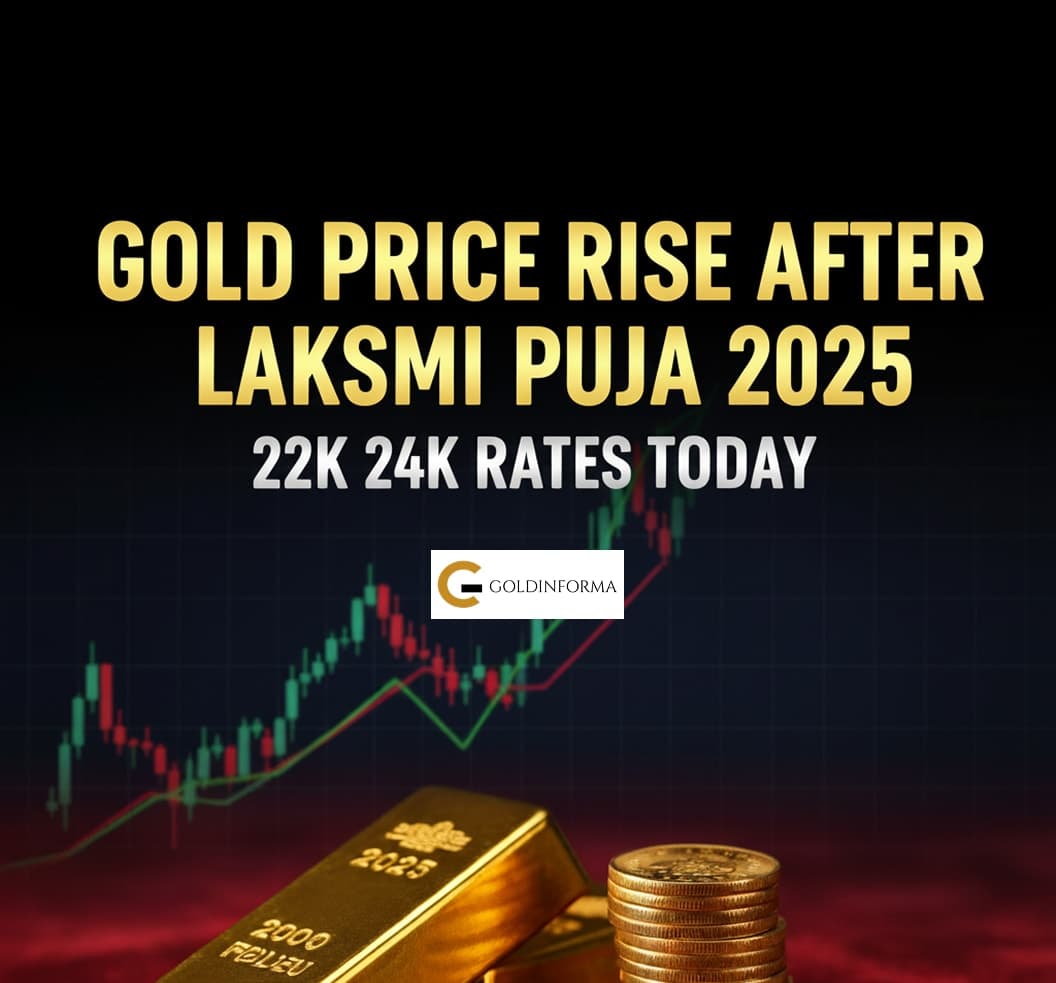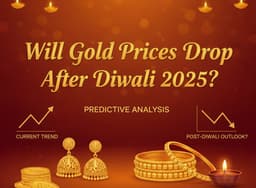Gold prices surged dramatically after Lakshmi Puja 2025, with 22-karat gold climbing ₹270-305 per gram and 24-karat gold gaining ₹295-333 per gram across Indian cities. The precious metal hit lifetime highs ahead of Dhanteras, reflecting massive festive buying, record international prices, and strong safe-haven demand amid global economic uncertainty.
The festival celebrations brought record-breaking gold prices this year. As families gathered to worship Goddess Lakshmi, the yellow metal reached unprecedented levels, touching ₹13,277 per gram for 24K in some cities. If you're tracking prices or planning to buy, here's what's really happening in the market right now.
Why Gold Rates Skyrocketed After Lakshmi Puja
The 2025 Diwali season witnessed one of the sharpest gold rallies in recent years. Multiple factors combined to create this perfect storm.
Festive demand broke all previous records. Jewelers across India reported sales exceeding last year's numbers by nearly 30%. When millions of households buy gold simultaneously during Lakshmi Puja, prices naturally respond. This year's buying spree was particularly intense because many investors had been waiting for the auspicious timing.
International gold prices provided additional momentum. Global gold crossed $4,300 per ounce—a historic milestone. US-China trade tensions escalated during this period, with both nations imposing new restrictions on critical exports. Whenever geopolitical stress increases, investors worldwide rush to gold as a safe haven. This international surge directly impacted Indian prices.
The rupee-dollar equation added another layer. With the rupee hovering around ₹87.92 per dollar, import costs climbed significantly. India imports over 800 tonnes of gold annually, and every rupee depreciation translates to higher domestic prices.
Currency fluctuations weren't the only concern. Central banks continued their aggressive gold accumulation, adding tonnes to their reserves throughout 2025. When institutional buyers compete with retail demand, supply tightens and prices climb.
Current 22K and 24K Gold Rates Across Cities
Let's get to the numbers everyone's watching.
22-karat gold currently ranges between ₹11,765 to ₹12,170 per gram across major Indian cities. This 91.6% pure gold remains the default choice for wedding jewelry, traditional designs, and everyday ornaments. Its durability makes it practical for pieces you'll actually wear.
24-karat gold trades at ₹12,844 to ₹13,277 per gram, depending on your location. Being 99.9% pure, this is what serious investors prefer. Gold coins, bars, and bullion biscuits typically come in 24K purity, offering better resale value and standardized pricing.
For those watching gold rate in Mumbai, the financial capital currently quotes 22K at ₹12,035 per gram and 24K at ₹13,129 per gram. Mumbai's massive jewelry market and direct port access usually keep rates competitive. The city processes the majority of India's gold imports, giving local buyers a slight price advantage over inland cities.
International comparison helps put these numbers in perspective. Check the gold rate in USA where gold currently trades around $4,376 per ounce—approximately $140.70 per gram. That converts to roughly ₹12,375 per gram at current exchange rates. American investors are also experiencing record highs, driven by Federal Reserve rate cut expectations and persistent inflation concerns.
Indian expatriates and frequent travelers often compare with gold rate in Saudi Arabia, where 22K sells at approximately SAR 441.71 per gram (around ₹10,356). The Gulf region's zero VAT policy on gold makes it attractive for purchases. Many NRI families strategically time their gold buying during Middle East visits or arrange shipments through trusted channels.
The Sacred Bond: Lakshmi and Gold in 2025
Why does this ancient tradition still drive modern markets?
Goddess Lakshmi embodies wealth, and gold has represented stored value for millennia. Purchasing gold during Lakshmi Puja isn't just religious sentiment—it's a cultural investment strategy passed down generations. The belief that buying gold on this day brings year-round prosperity creates real economic impact.
This year's Lakshmi Puja (October 2025) coincided with particularly bullish market sentiment. Young professionals bought their first gold coins. Parents purchased jewelry for children's future weddings. Investors added to their portfolios. From tier-1 cities to small towns, the gold-buying movement swept across India within a 48-hour window.
Jewelers had prepared for months, stocking designs and arranging credit facilities. Yet demand exceeded even optimistic projections. Several outlets in Mumbai, Delhi, and Bangalore reported selling out popular coin denominations by evening. The industry estimates this year's Diwali season sales will exceed ₹45,000 crore—a new benchmark.
Digital gold platforms also recorded unprecedented activity. Younger buyers, comfortable with app-based investing, poured money into digital gold. This demographic shift is expanding the traditional gold market into new territories.
Should You Buy Gold Right Now?
This question becomes harder when prices hit all-time highs.
If you need gold for an imminent wedding or special occasion, timing considerations become secondary. Wedding dates won't wait for market corrections. However, smart buyers can still optimize. Instead of buying everything at once, consider phased purchases. Buy essential pieces now, defer optional items for 30-60 days. This approach averages out price volatility.
For pure investors, the calculation differs significantly. Yes, gold hit record highs, but underlying fundamentals remain supportive. Global economic uncertainty continues. Inflation hasn't vanished. Geopolitical tensions show no signs of easing. These factors traditionally support gold prices.
However, history suggests post-festival corrections are common. Once Dhanteras and wedding season demand normalizes (typically by March-April), we often see price stabilization or modest dips. If you're investing for the long term, waiting 2-3 weeks might offer better entry points.
Expert forecasts for 2026 range widely. Bulls predict ₹15,000 per gram for 24K gold by year-end, citing continued global instability and rupee weakness. Bears argue that current prices already factor in most negative scenarios, leaving limited upside. The reality likely falls somewhere between.
Long-term wealth builders shouldn't obsess over perfect timing. Gold has appreciated consistently over decades. Whether you buy at ₹13,000 or ₹12,700 won't materially impact 10-year returns. Systematic monthly purchases remain the smartest strategy for most investors.
Smart Tips for Buying Gold in Today's Market
Before making any gold purchase, keep these practical points in mind:
Check morning rates religiously. Prices update multiple times daily based on MCX futures and international spot prices. Most jewelers post updated rates by 10 AM. Don't assume yesterday's rate still applies—always confirm before visiting stores.
Understand your final bill components. The displayed gold rate is just the starting point. Your actual payment includes making charges (₹350-800 per gram), GST (3% on gold value), GST on making charges (5%), and sometimes wastage charges (2-8%). A ₹12,000/gram gold rate can become ₹13,800/gram after all additions. Demand itemized billing.
Insist on proper hallmarking. BIS hallmarking is now mandatory across India. Look for the six-digit HUID (Hallmark Unique Identification) number on every piece. This connects jewelry to its certification database. Scan the QR code using official BIS apps to verify authenticity. Don't accept excuses about hallmarking delays.
Compare making charges aggressively. This is where jewelers' profit margins vary dramatically. One store might charge ₹400/gram while another demands ₹750/gram for comparable designs. For plain gold jewelry like chains or simple bangles, making charges should be minimal. Negotiate hard—most jewelers have flexibility here.
Consider digital gold for pure investment. If you're not buying jewelry, digital gold platforms offer 24K purity starting from ₹100. Zero making charges, secure storage, and instant liquidity. You can convert to physical gold later when needed. Current high prices make digital gold's fractional buying advantage particularly valuable.
Buy from established jewelers only. Don't chase discounts from unknown sellers or online marketplaces without proper credentials. Purity fraud remains a real risk. Stick to jewelers with decades of presence, positive reviews, and transparent practices. Your safety is worth more than ₹50/gram savings.
What's Next for Gold Prices?
Market watchers are divided on near-term direction.
Optimists see multiple price catalysts ahead. The wedding season (November through March) provides strong structural demand. Global central bank buying continues unabated. If US-China trade tensions escalate further, safe-haven demand could push gold to ₹14,000 per gram for 24K. Technical analysts point to strong momentum indicators suggesting more upside.
Skeptics anticipate corrections once festive buying subsides. They expect prices to shed ₹500-1,000 per 10 grams as post-Diwali and post-Dhanteras demand normalizes. Some analysts believe current prices already discount most negative scenarios, leaving limited room for further gains. Profit-booking by short-term traders could trigger temporary declines.
Currency movements will play the decisive role. If the rupee weakens beyond ₹90 per dollar, import costs rise automatically, pushing domestic prices higher regardless of international trends. Conversely, rupee strength could provide some relief despite global gold rallies. Monitor USD-INR rates as closely as gold prices.
Federal Reserve policy decisions matter enormously. If the Fed cuts rates more aggressively than expected, gold typically benefits. Lower interest rates reduce the opportunity cost of holding non-yielding assets like gold. Conversely, if inflation proves stickier and forces the Fed to maintain higher rates longer, gold could face headwinds.
The one certainty is volatility. Gold won't move in straight lines. Expect daily swings, weekly fluctuations, and sudden surprises. Plan purchases with this volatility in mind rather than trying to time the absolute bottom.
Frequently Asked Questions
1. Why does gold always become expensive after Lakshmi Puja?
The surge happens because millions of Indians buy gold during Diwali and Lakshmi Puja simultaneously, creating massive demand that outstrips immediate supply. This tradition combines religious significance with investment strategy—families believe buying gold on this auspicious day brings prosperity. Jewelers anticipate this annual spike, but the sheer volume of purchases invariably pushes prices higher. In 2025, the increase was particularly sharp due to record international gold prices coinciding with festive demand.
2. What's the actual difference in cost between 22K and 24K gold today?
24-karat gold currently costs ₹450-1,100 more per gram than 22-karat gold, depending on your city. This premium reflects the higher pure gold content (99.9% vs 91.6%). For a typical 10-gram purchase, you'd pay ₹4,500-11,000 extra for 24K. However, 24K is better for investment purposes with superior resale value, while 22K is more practical for jewelry due to added metal strength. Choose based on your purpose—investment favors 24K, wearable jewelry needs 22K.
3. How can I verify if today's gold rate in my city is fair?
Compare your jeweler's rate against three sources: (1) MCX gold futures prices published on commodity exchanges, (2) rates declared by your local bullion or Sarafa association, and (3) prices from 3-4 competing jewelers in your area. If one jeweler's rate exceeds others by ₹100+ per gram without clear explanation, that's suspicious. Many gold rate aggregator websites list city-wise rates updated hourly. Your rate should fall within ±₹50 of the prevailing market rate for your city.
4. Will gold prices drop after the wedding season ends in March 2026?
Historical patterns show prices often stabilize or dip slightly after peak wedding season as demand normalizes. However, 2025-26 may differ because international factors—global economic uncertainty, US-China tensions, and central bank buying—are unusually strong. These structural supports could override seasonal patterns. If you're not buying for an immediate need, waiting until March might offer marginally better rates, but it's not guaranteed. For long-term investors, waiting 3-4 months matters less than consistent accumulation regardless of short-term moves.
5. Is buying digital gold at current high prices smarter than physical gold?
Digital gold offers distinct advantages when prices are elevated. You can invest small amounts (starting ₹100) regularly instead of committing large sums at peak prices—this rupee-cost averaging smoothens volatility impact. There are zero making charges, no storage costs, and instant liquidity. You can convert to physical gold later if needed. However, digital gold lacks the emotional satisfaction and cultural value of physical jewelry. For pure investment purposes during high-price periods, digital gold is objectively smarter. For jewelry needs or gifts, physical gold remains necessary despite higher costs.
Disclaimer: Gold prices fluctuate continuously based on international markets, currency exchange rates, and local demand. Rates mentioned are indicative and vary by location, jeweler, and time of day. This article provides information only, not financial advice. Consult certified financial advisors before making investment decisions. Past price trends don't guarantee future performance.




